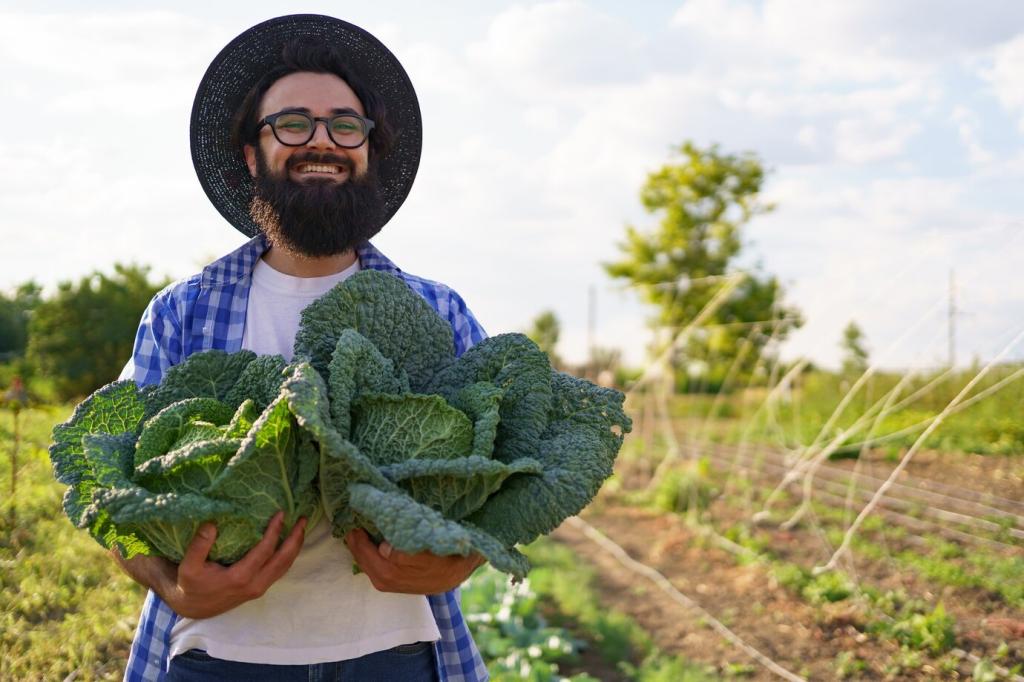Urban Agriculture Innovations for Sustainability
Urban agriculture is transforming cities into vibrant hubs of food production, environmental stewardship, and community engagement. As urban populations swell and environmental challenges mount, innovative practices in urban farming offer sustainable solutions for food security, local economies, and reducing the ecological footprint of our cities. Through the creative use of technology, resource management, and social collaboration, urban agriculture has become a beacon of resilience and sustainability for modern city life.
Integrating Vertical Farming in City Landscapes
Optimizing Space with Hydroponic Towers
Hydroponic towers have become a staple in urban agriculture by allowing crops to grow in vertically stacked columns without soil. This approach uses nutrient-rich water and controlled environments to accelerate plant growth while conserving water and space. Urban dwellers can place these towers on rooftops, balconies, or even indoors, making fresh greens and herbs readily accessible year-round. By eliminating the need for vast tracts of arable land and traditional irrigation, hydroponic towers address space constraints and reduce overall resource consumption, marking a major leap toward greener urban living.
Automated Climate Control in Vertical Farms
Climate-controlled vertical farms incorporate advanced sensors and automation to precisely regulate factors such as light, humidity, and temperature. This innovation allows farmers to tailor growing conditions to a plant’s specific needs, maximizing yield and cutting down on wasted resources like water and electricity. Controlled environments can also protect crops from pests and diseases common in outdoor settings, negating the need for chemical pesticides. As a result, urban vertical farms can consistently deliver high-quality, pesticide-free produce, even in challenging climates or densely populated urban centers.
Urban Design Integration for Community Benefit
Successful vertical farming initiatives thoughtfully blend into city infrastructure, transforming underutilized spaces such as parking structures and abandoned buildings into productive agricultural hubs. By repurposing these urban environments, cities not only address food insecurity but also foster aesthetic improvements and community pride. Such integrations encourage residents to participate in learning about local food systems, promoting environmental awareness and enhancing the social fabric of urban neighborhoods through shared green spaces and volunteer opportunities.
Green roofs act as natural insulators, absorbing sunlight and lowering rooftop temperatures, which can have a profound effect on combating the urban heat island phenomenon. By mitigating temperature extremes, these vegetative layers reduce a building’s energy consumption for cooling, translating into lower greenhouse gas emissions. Moreover, the added greenery creates pleasant outdoor spaces for urban relaxation and socialization, contributing both environmental benefits and a higher quality of life for residents and office workers alike.


Many urban farms are pioneering closed-loop water systems, where water is reused and circulated through various stages of crop production. Techniques such as drip irrigation and nutrient film technology ensure that plants receive only the water they need, drastically reducing waste compared to traditional farming. Some setups even capture and purify greywater from nearby buildings for agricultural use, turning potential waste into a valuable resource. These water-saving strategies are especially vital for cities prone to drought or with limited freshwater availability, highlighting urban agriculture’s potential for resiliency under changing climate conditions.

Innovative urban farms are harnessing renewable energy sources like solar panels and wind turbines to reduce their carbon footprint. By generating clean electricity on-site, urban growers can power lighting, climate control, and irrigation systems in a sustainable way. Energy-efficient greenhouses use advanced insulation and adaptive technologies to minimize energy demand. These efforts not only contribute to urban sustainability but also empower local communities by making food production less reliant on external and nonrenewable power sources.

Urban farms are closing nutrient loops by converting city food scraps and organic waste into compost and natural fertilizers. On-site composting facilities transform potential landfill materials into rich, valuable inputs for plant growth. This practice reduces municipal waste disposal costs and methane emissions while providing a steady supply of nutrients to fuel healthy urban crops. The process engages local residents, food businesses, and community organizations in sustainable waste solutions and reinforces the interconnectedness of urban life and food systems.
Advances in Urban Aquaponics and Aquaculture
01
Aquaponic systems combine fish tanks and hydroponic beds in a mutually beneficial cycle: fish produce nutrient-rich waste that feeds plant growth, while plants purify water for the fish. This eco-friendly balance increases productivity without the need for chemical fertilizers or pesticides. By carefully managing fish and plant populations, urban aquaponics practitioners achieve higher-yield, lower-impact farming within compact spaces, exemplifying the synergy between ecological principles and technological innovation in urban environments.
02
Urban aquaculture experiments with diverse fish species, from tilapia and catfish to ornamental koi and edible freshwater shrimp. Choosing species suited to recirculating water systems, varying temperatures, and local market preferences is critical. Innovative breeding programs and careful population management ensure that urban aquafarms remain sustainable and disease-resistant. This adaptability allows city farms to supply both nutrient-dense produce and fresh fish protein, diversifying urban diets while promoting efficient use of resources.
03
Many urban aquaponics projects are rooted in educational and community-based endeavors. By establishing pilot sites in schools, community centers, and public spaces, practitioners foster hands-on learning about sustainability, food production, and ecosystem health. These programs inspire urban residents of all ages to reconnect with food sources, understand the science behind closed-loop farming, and develop skills for future careers in environmental stewardship and agricultural innovation.
Enhancing Food Security and Access in Cities
Food hubs serve as centralized spaces where small urban producers aggregate, process, and distribute their harvests directly to consumers, retailers, and institutions. These hubs streamline logistics, reduce costs, and provide greater market access for local growers. By shortening supply chains and focusing on fresh foods, urban food hubs help to increase the availability of nutritious options in communities that struggle with conventional grocery access, thus fortifying urban food resilience.
To bring fresh produce directly to city neighborhoods lacking grocery stores, urban agriculture initiatives are deploying mobile markets and on-site farm stands. Repurposed buses, trucks, and pop-up stands travel city streets to reach communities with limited access to healthy food. These efforts not only supply fruits, vegetables, and herbs but also stimulate local economies by supporting small-scale farmers. Educational outreach and cooking demonstrations further encourage urban residents to integrate healthy, seasonal foods into their diets.
Progressive urban agricultural policies and innovative social enterprise models are making sustainable city farming more accessible to marginalized communities. By granting access to land, funding, and technical support, municipal governments and nonprofits remove barriers for new growers. Social enterprise programs reinvest profits into community projects and educational initiatives, ensuring that the benefits of urban agriculture reach the most vulnerable urban populations and foster lasting, systemic change in city food landscapes.
Harnessing Smart Technology for Urban Farming Efficiency
The Internet of Things (IoT) enables real-time monitoring and control of urban farms through interconnected sensors and devices. Soil-moisture sensors, automated watering systems, and climate controllers provide detailed feedback and actionable data, allowing growers to optimize conditions for each crop. Predictive analytics flag potential issues before they become problems, reducing crop losses and resource waste. These technological advances empower urban farmers—even those with less agricultural experience—to consistently produce high-quality yields with minimal intervention.

Community Engagement and Urban Agriculture Education
School-based agriculture programs introduce students to food growing, ecological stewardship, and healthy eating from an early age. By creating hands-on learning environments, school gardens foster curiosity, teamwork, and practical skills that go beyond textbooks. Children discover where their food comes from, develop lifelong healthy habits, and become ambassadors for sustainability in their families and neighborhoods. These programs lay the groundwork for future innovators who will help shape the cities of tomorrow.
Urban agriculture collectives bring together diverse city residents to share land, labor, tools, and knowledge. These collaborative efforts transform vacant lots and idle land into flourishing gardens, strengthen social networks, and create opportunities for skill-sharing across cultures and generations. By empowering communities to grow food and make collective decisions, urban farming collectives foster resilience, self-sufficiency, and a shared sense of purpose in rapidly changing urban landscapes.
Regular workshops, festivals, and open farm days create opportunities for city dwellers to engage directly with urban agriculture. Participants can learn about everything from composting and seed saving to hydroponics and rooftop beekeeping. These events demystify urban farming, encourage environmental awareness, and inspire residents to start their own home gardens or support local farms. Through education and participation, urban agriculture becomes a dynamic force for positive change in city communities.
